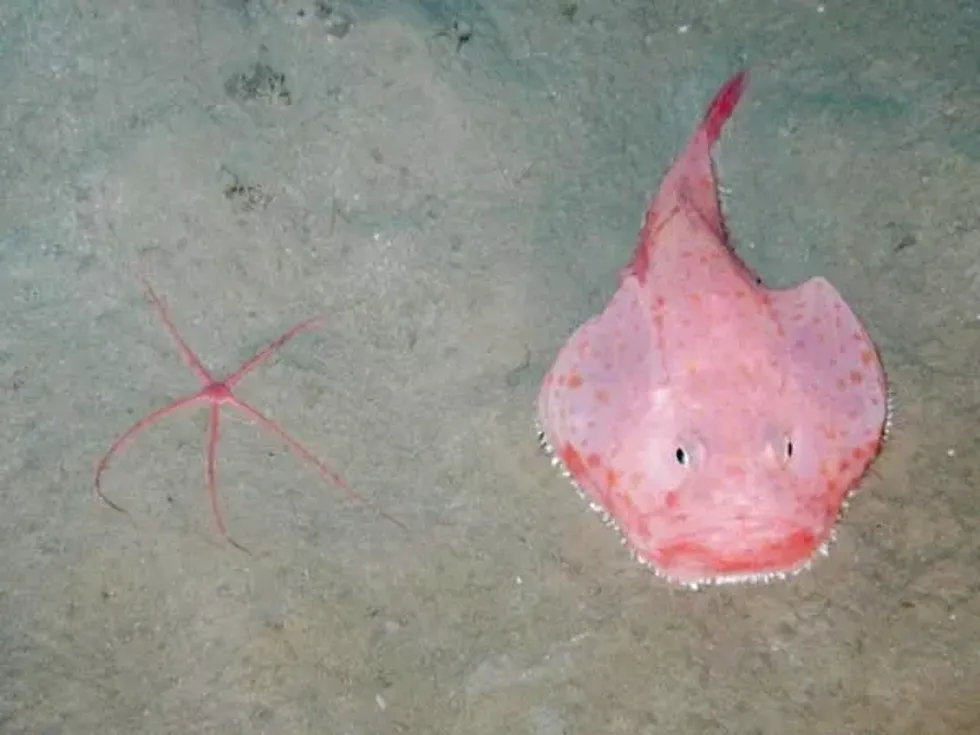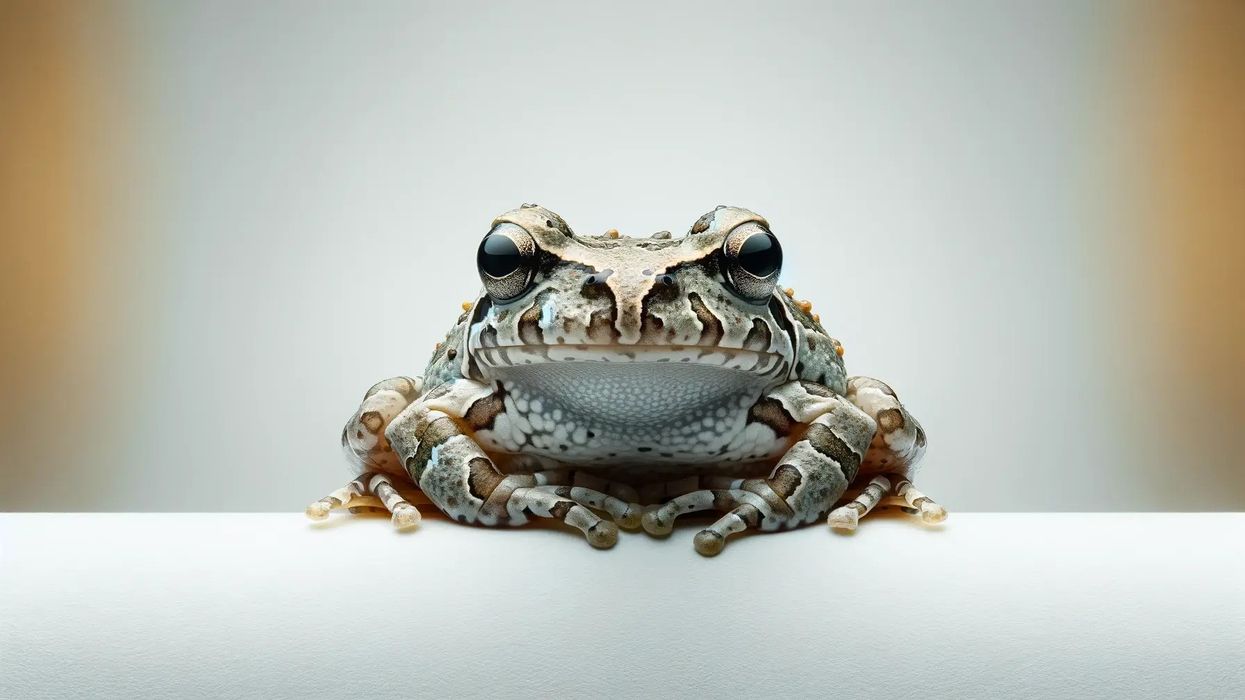The pink frogmouth is a deep-sea fish found in the tropical and temperate regions of oceans all over the world but it is not found in the Caribbean Sea.
It belongs to the family of deep-sea anglerfishes (Chaunacidae) which also includes sea toads and coffinfishes.
Deep inside the ocean, the fish roams the seafloor in such a way that its fins act like its four legs and it seems to walk around rather than swim. These fishes usually dwell in the tropical continental slopes of the Atlantic ocean and the Mediterranean sea at a depth of 656-1968 ft (200-600 m).
The pink frogmouth species get their name directly from their physical appearance as the fish has a pink complexion on their body and their mouth resembles the mouth of a frog.
One unique feature of this species of fish is that it can hold its breath. Normally, a fish breathes through its gills by swallowing the water with oxygen and releasing the water through its gills after absorbing the oxygen.
The pink frogmouth can retain the water inside its gills for three to four minutes which also increases its weight by 30%. The increase in weight makes the fish puffier which helps it to conserve energy in low prey habitats and also acts as a defense mechanism against enemies.
Want to know more about fish? Here are some interesting facts about salmon and suckerfish.
Pink Frogmouth Interesting Facts
What type of animal is a pink frogmouth?
A pink frogmouth is a deep-sea fish that belongs to the family of Chaunacidae.
What class of animal does a pink frogmouth belong to?
A pink frogmouth belongs to the class Actinopterygii.
How many pink frogmouths are there in the world?
The pink frogmouth is scattered all over the world in the continental slopes of tropical and temperate regions, for this reason, the exact number of pink frogmouths in the world is unknown.
Where does a pink frogmouth live?
A pink frogmouth lives in the tropical and temperate regions of the continental slopes of the Atlantic Ocean and the Mediterranean Sea. There are no traces of these fishes in the Caribbean sea.
What is a pink frogmouth's habitat?
The pink frogmouth mainly resides at depths of 656-1968 ft (200-600 m). It is a deep-sea fish and cannot be seen on the surface which swims in such a way on the seafloor it seems like it is using its fins to walk.
Who do pink frogmouths live with?
Pink frogmouths live with their own kind of fish and may also be found in schools with the fishes of its family of anglerfishes (Chaunacidae).
How long does a pink frogmouth live?
A pink frogmouth lives for up to five years like other anglerfishes of the family Chaunacidae.
How do they reproduce?
Pink frogmouths are iteroparous. This means they produce offspring multiple times in their lifecycle. These fishes have a tendency to have breeding territory for protecting their eggs. The female fish selects their mates once they are ready for breeding. While spawning, the female lays eggs in their territory and the male fish fertilizes them.
What is their conservation status?
According to the IUCN, the conservation status of the pink frogmouth is of Least Concern. They reside in the tropical areas of the continental slopes and may have some larger marine predators.
Pink Frogmouth Fun Facts
What does a pink frogmouth look like?

The fish has a pink complexion on its body and its mouth is similar to that of a frog. This species is 15 in (40 cm) long and it resides in the sea almost at a certain depth that its fins touch the seafloor which gives the illusion that the fish can walk.
How cute are they?
These species of fish have a frog-like mouth and a pink complexion on their body. The overall appearance of the fish is not very cute.
How do they communicate?
They communicate through signals in water and also by body movements.
How big is a pink frogmouth?
A pink frogmouth that belongs to the family of Chaunacidae is 15 in (40 cm) long. It has a special ability to hold the water inside their gills while breathing after absorbing the oxygen.
Their body weight increases by 30% when they hold the water and their body gets puffier. This helps them to save energy in areas of the ocean and sea, where their scarcity of prey and acts as a defense against their enemy. They are bigger than angelfish.
How fast can a pink frogmouth fly?
Pink frogmouth fish cannot fly. As for how fast they can swim, unfortunately, there have been no studies on how fast they are.
How much does a pink frogmouth weigh?
The exact weight of the pink frogmouth species is unknown.
What are the male and female names of the species?
The males and females do not have separate names. The only noticeable difference is the males have more prominent nostrils.
What would you call a baby pink frogmouth?
The baby pink frogmouth has not been given any particular name.
What do they eat?
Pink frogmouths (Chaunax pictus) have the same dietary requirements as the other species of its family Chaunacidae. They reside at a certain depth of about 2000 ft (600 m) where sometimes very few small marine organisms are encountered.
So they adopted an energy-saving mechanism to survive with less food. The family of fish is a steady predator. They make very slow movements so that their prey cannot sense their presence.
They prey on almost anything in the depth of 2000 ft (600 m). Their food may include small marine fishes like drum fish, lungfish, and blobfish.
Are they dangerous?
Chaunax pictus feed on small fishes and marine organisms on the continental slopes of the sea and the ocean. They are ferocious predators.
Would they make a good pet?
The pink frogmouth (Chaunax pictus) is deep-sea fish that belongs to the family of Chaunacidae, can be found at a depth of 656-1968 ft (200-600 m). They are marine organisms and are cleared as pets still now. They have not been proven harmful to humans but are not recommended as pets.
Did you know...
The pink frogmouth is not endemic but is spread all over the world in the tropical and temperate regions of the continental slopes of the oceans and the seas.
How many eggs do pink frogmouth lay?
The pink frogmouth (Chaunax pictus) belongs to the family of Chaunacidae and has multiple breeding seasons in one lifespan. There is not much information on the number of eggs it can lay, but it may easily lay a range of 300000 to 2800000 eggs.
How to spot pink frogmouth?
The pink frogmouth (Chaunax pictus), which belongs to the family of Chaunacidae, is easy to spot with some of its unique physical features. One of them being the way the dorsal fins touch the floor of the sea such that it seems like they are using their fins to walk on the floor of the sea.
Here at Kidadl, we have carefully created lots of interesting family-friendly animal facts for everyone to discover! Learn more about some other fish from our river chub fun facts or redtail catfish interesting facts for kids pages.
You can even occupy yourself at home by coloring in one of our free printable pink frogmouth coloring pages.










